
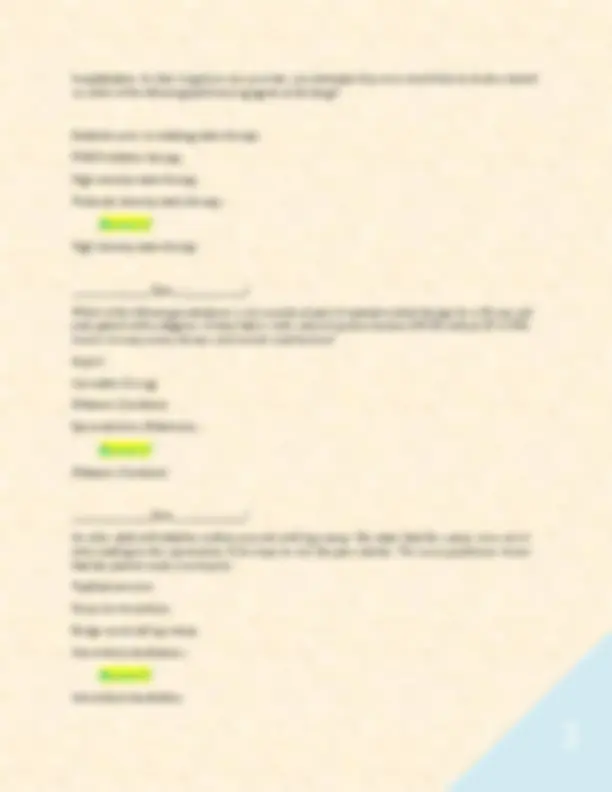
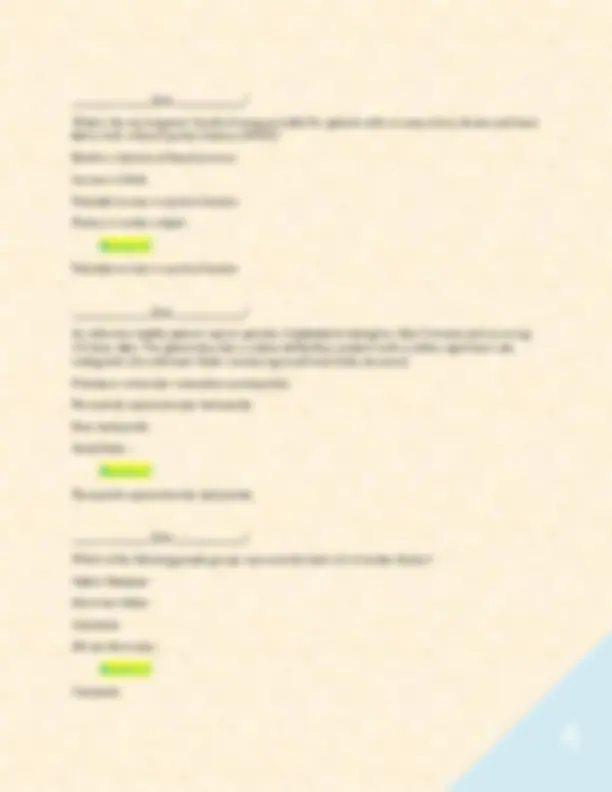
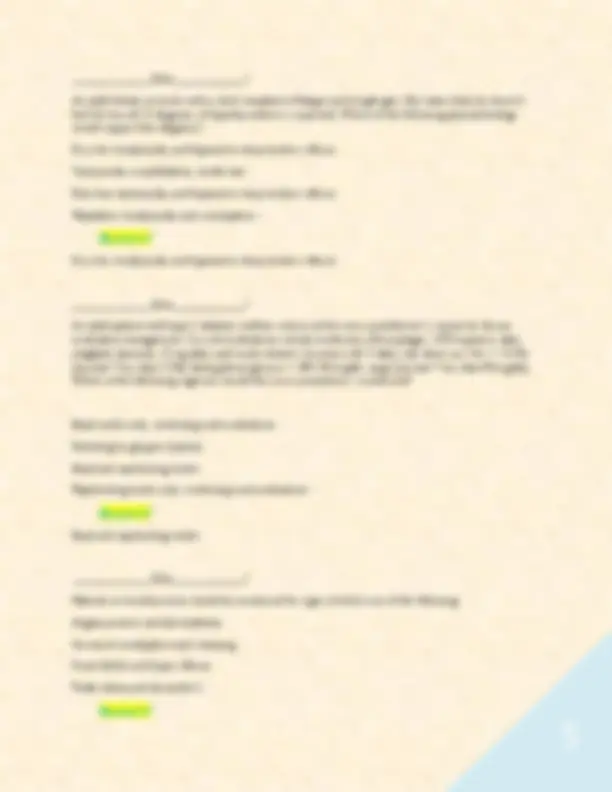
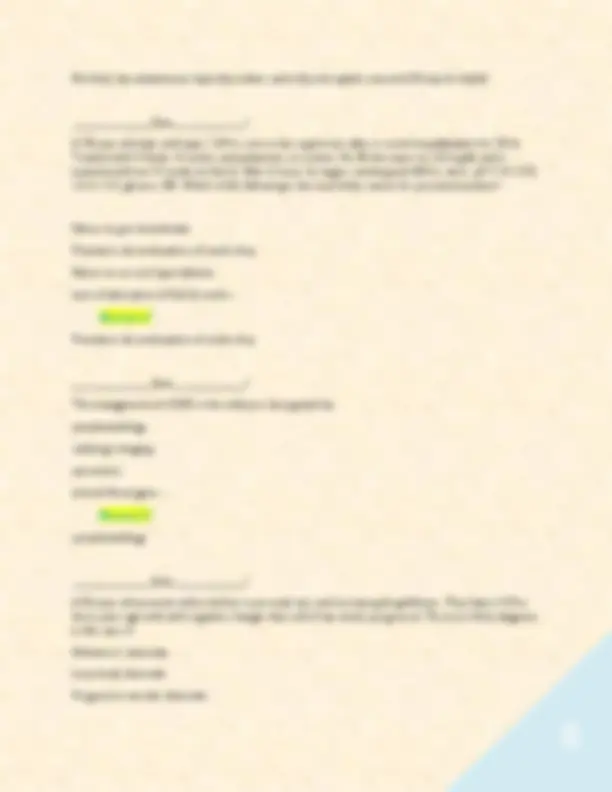
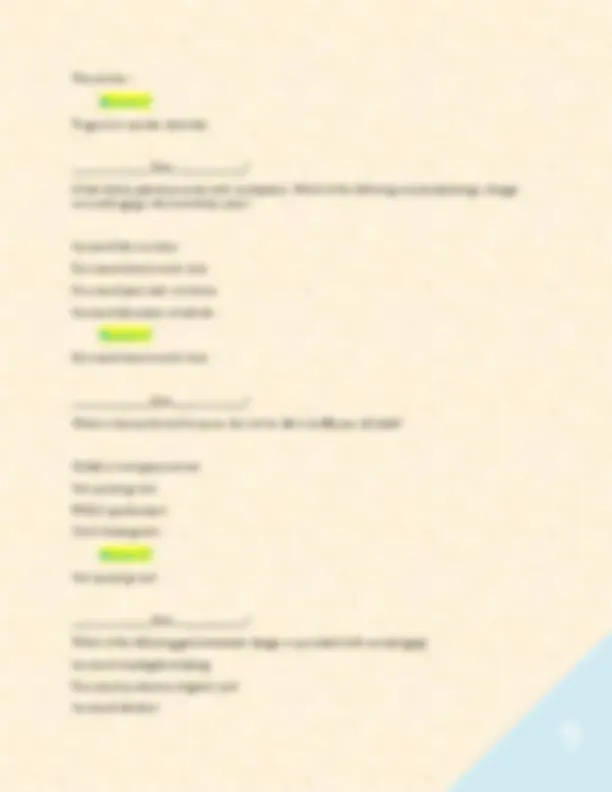
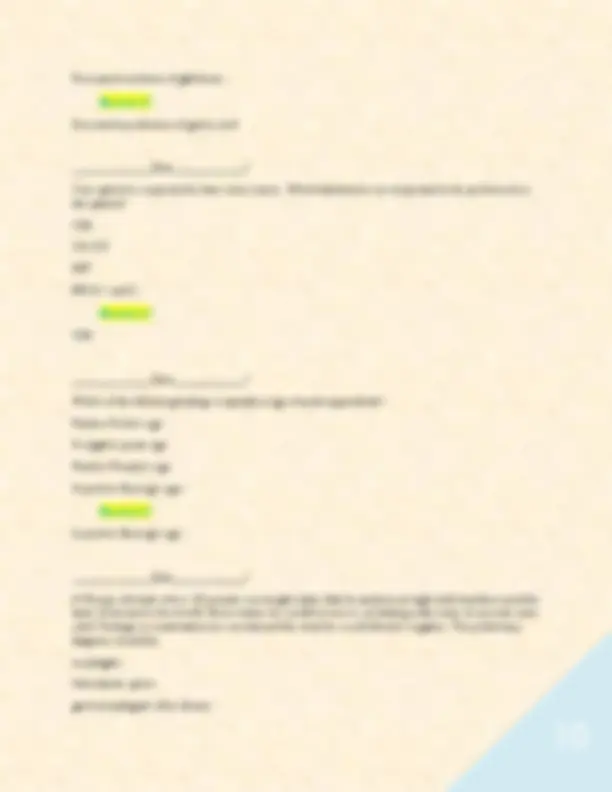
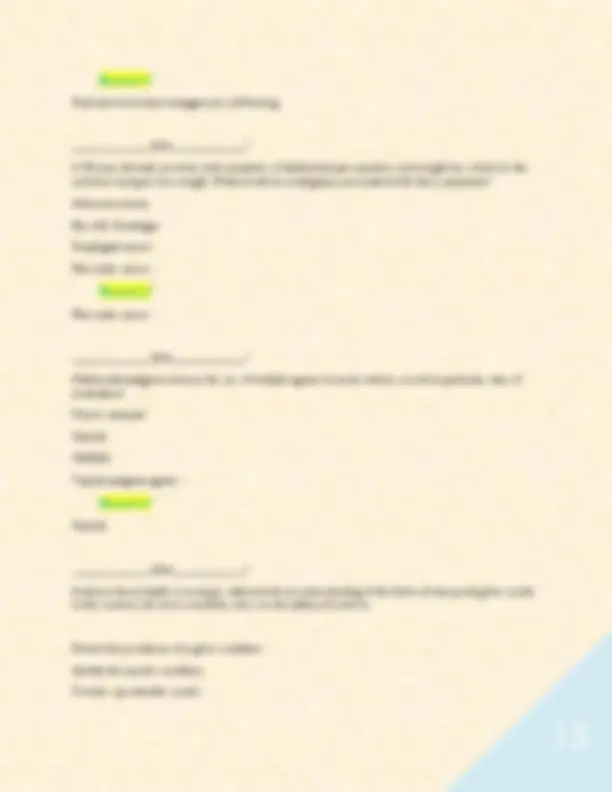
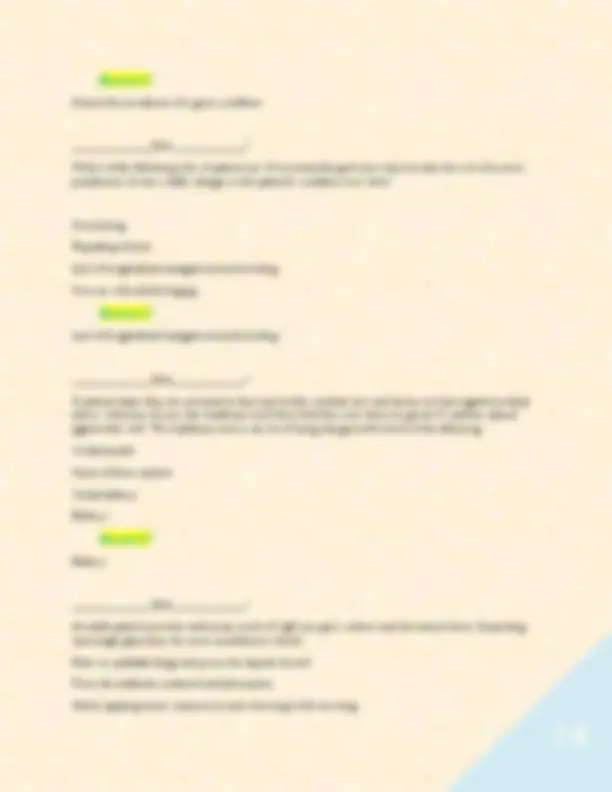
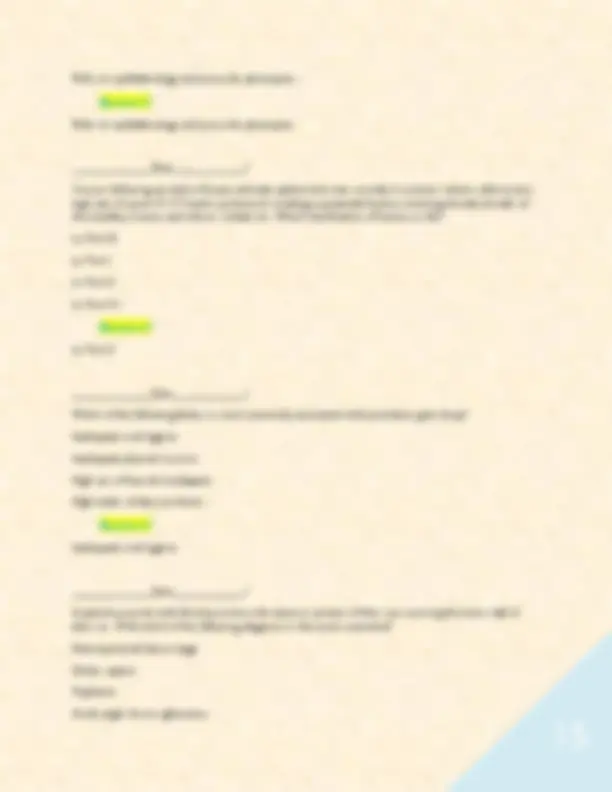
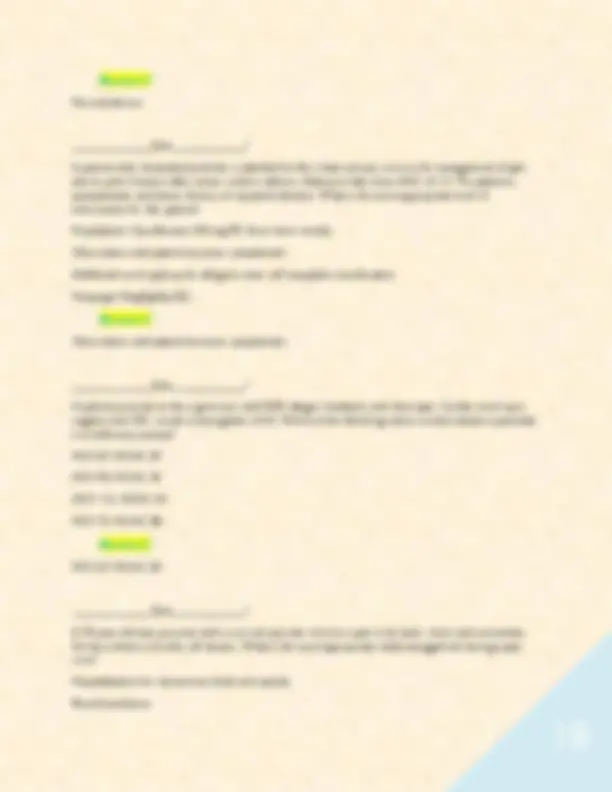
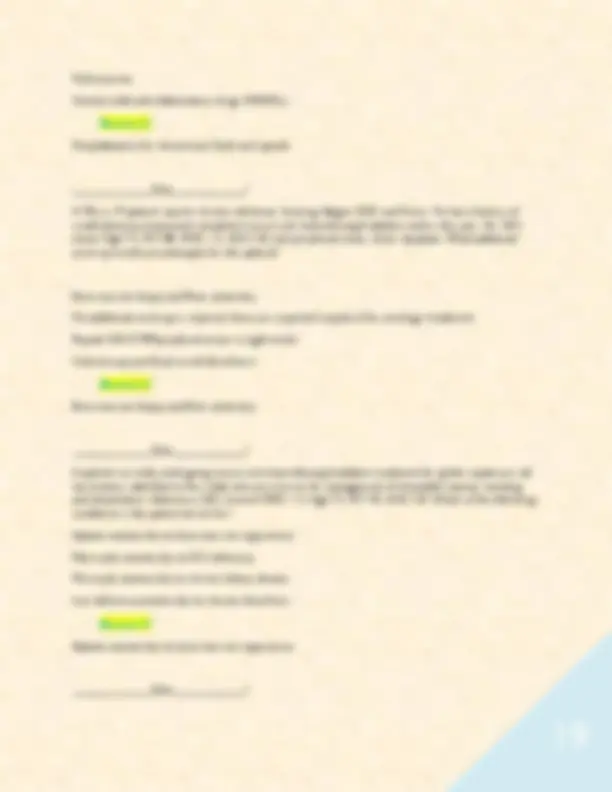
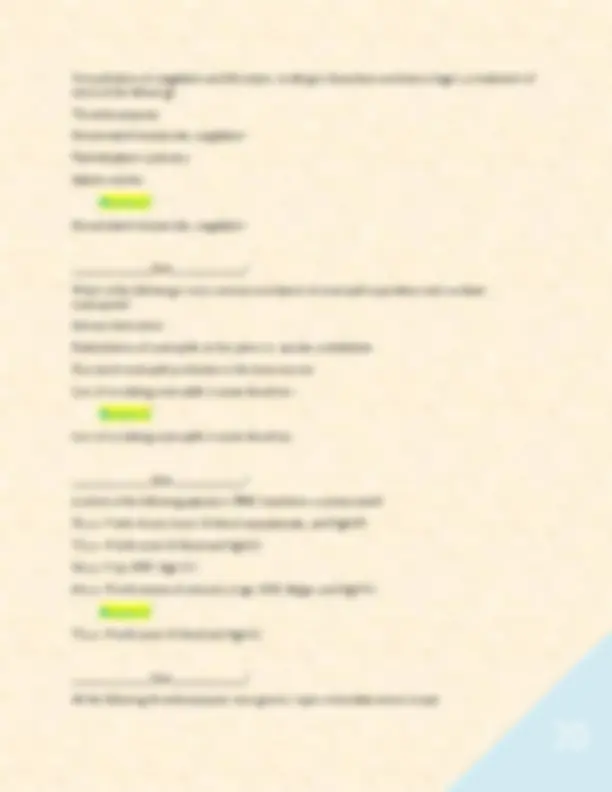
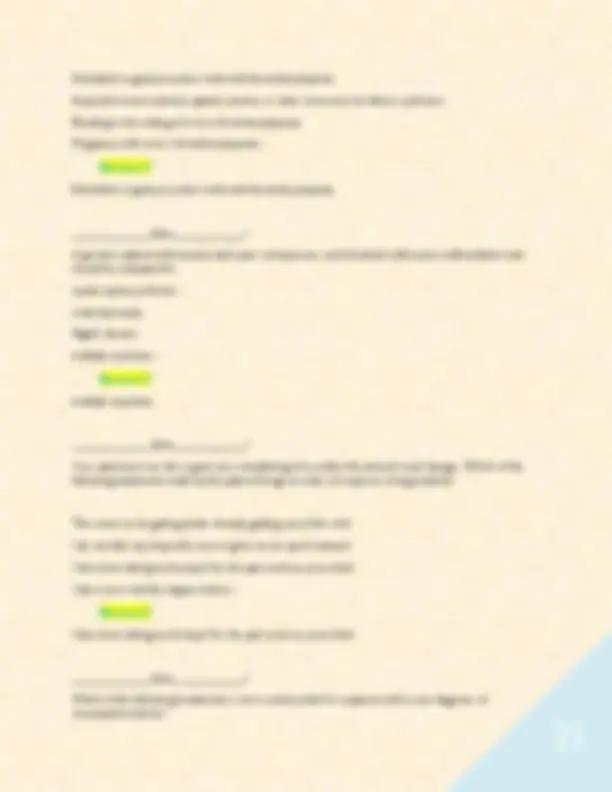
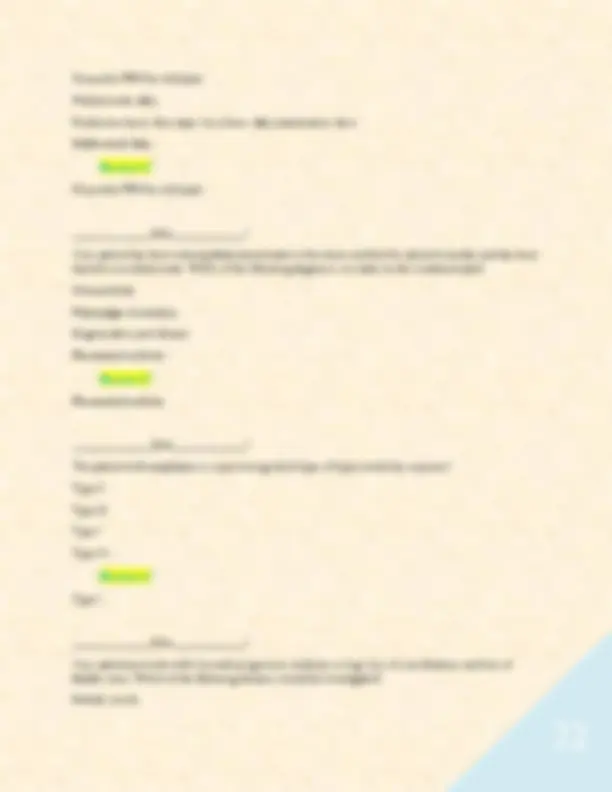
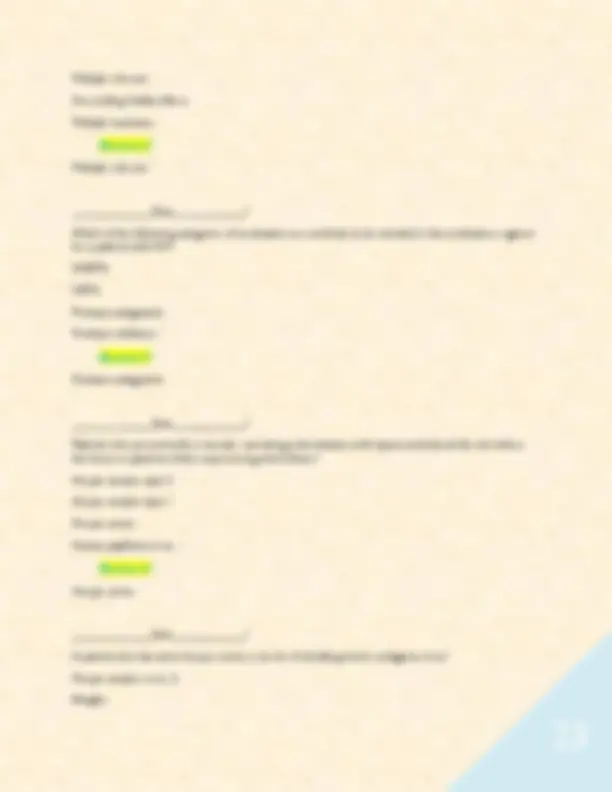
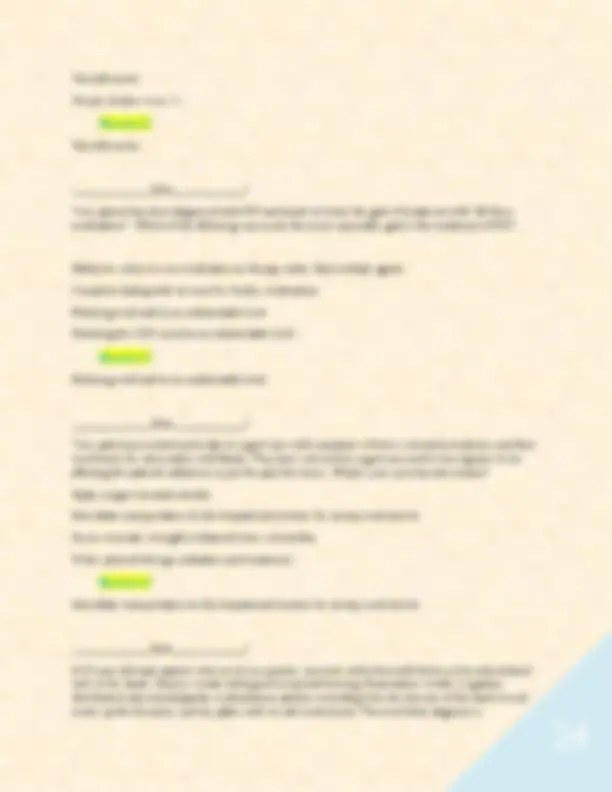
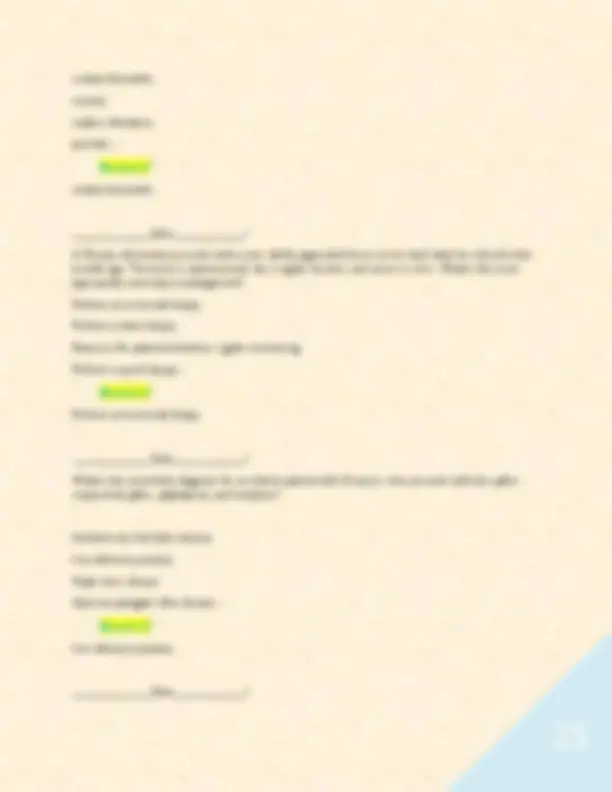
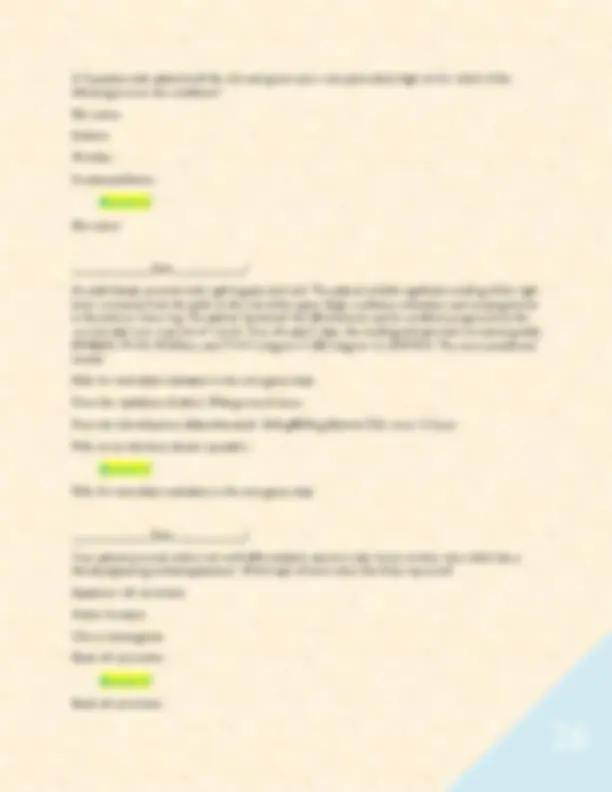
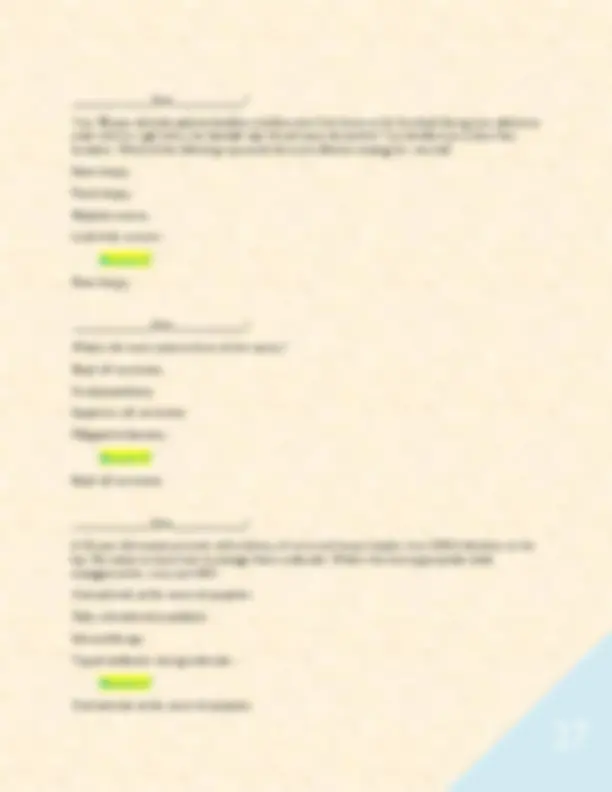
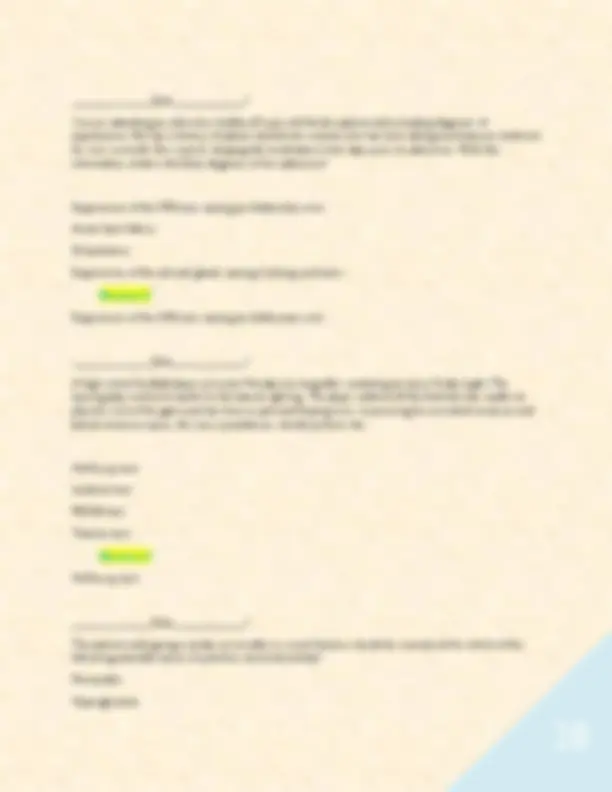
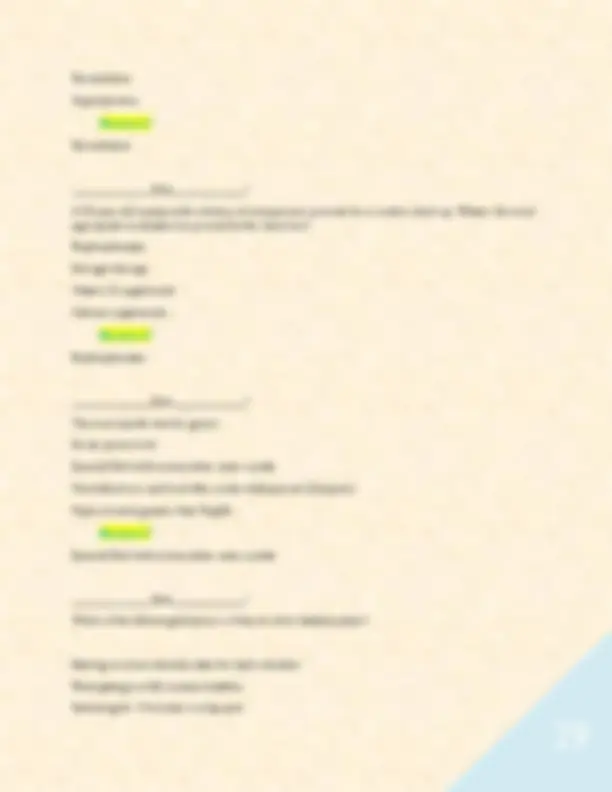
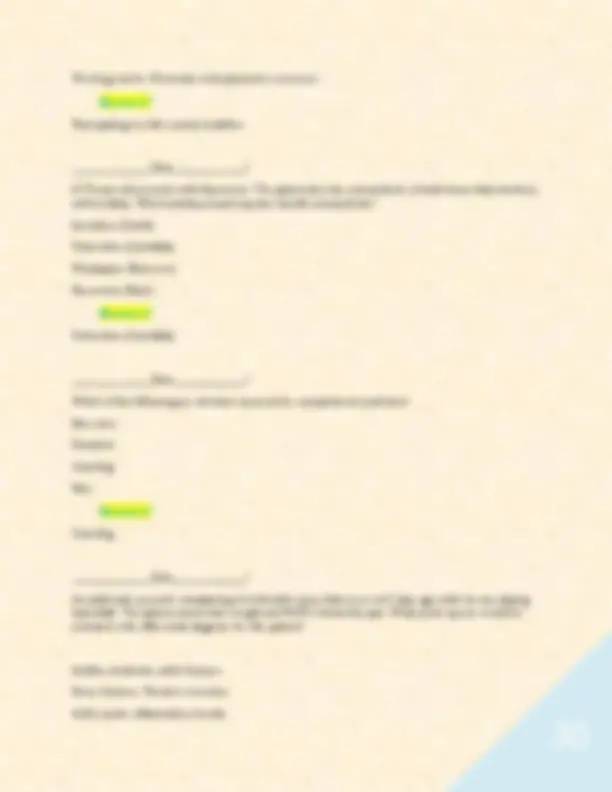
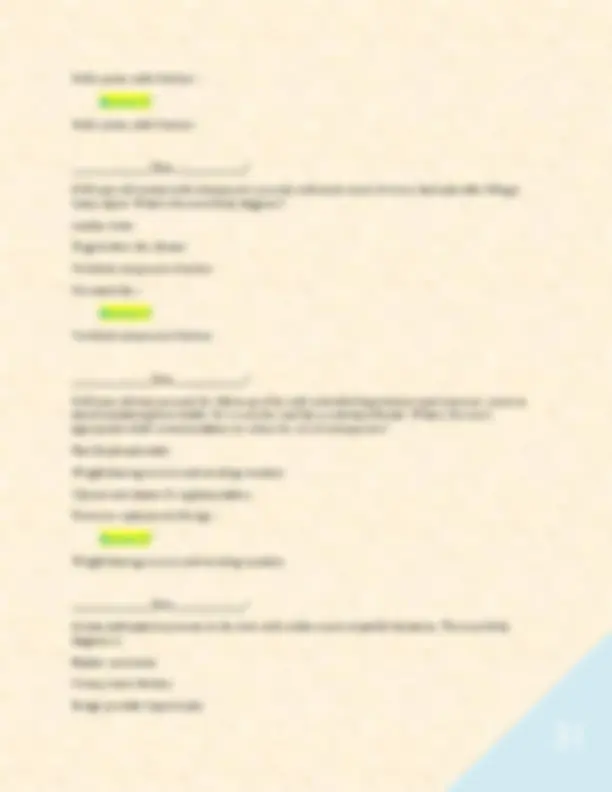
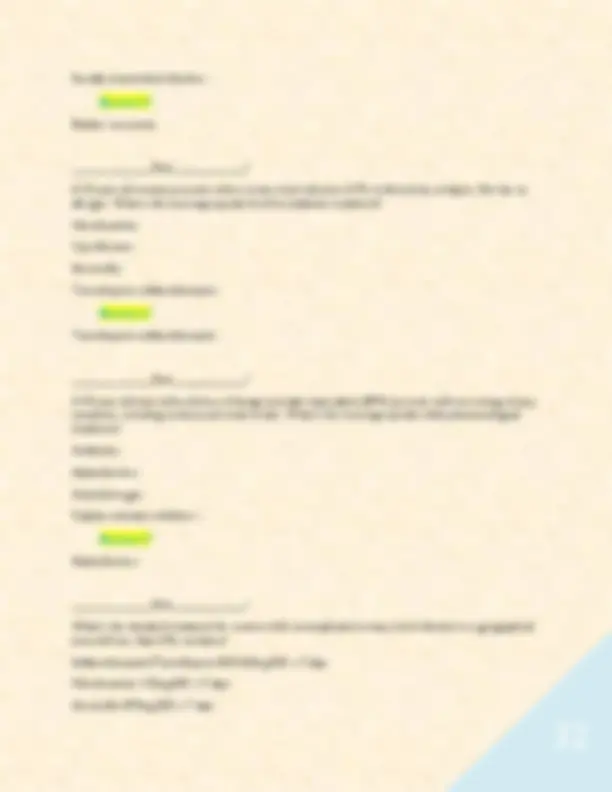
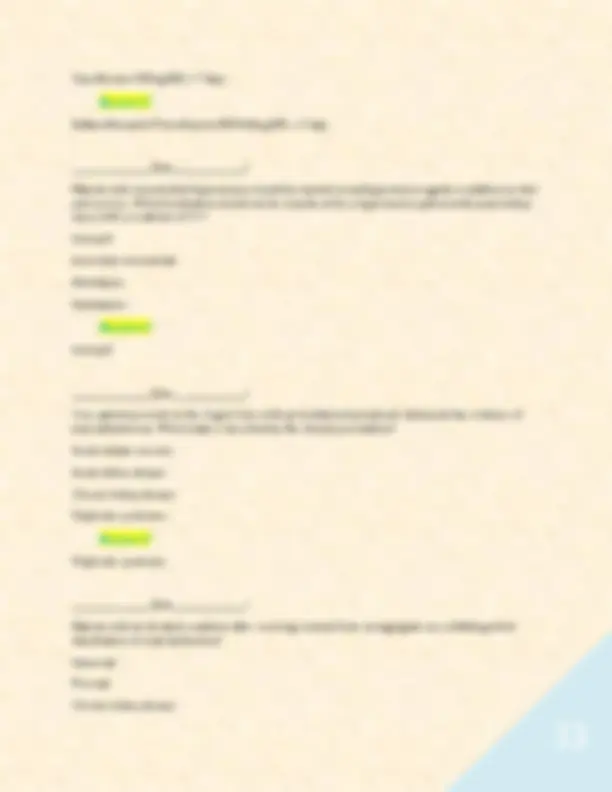
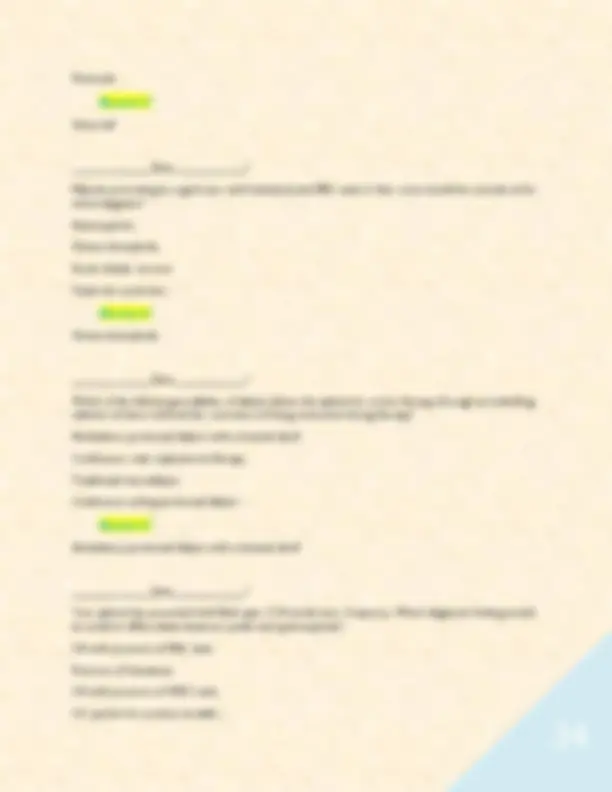
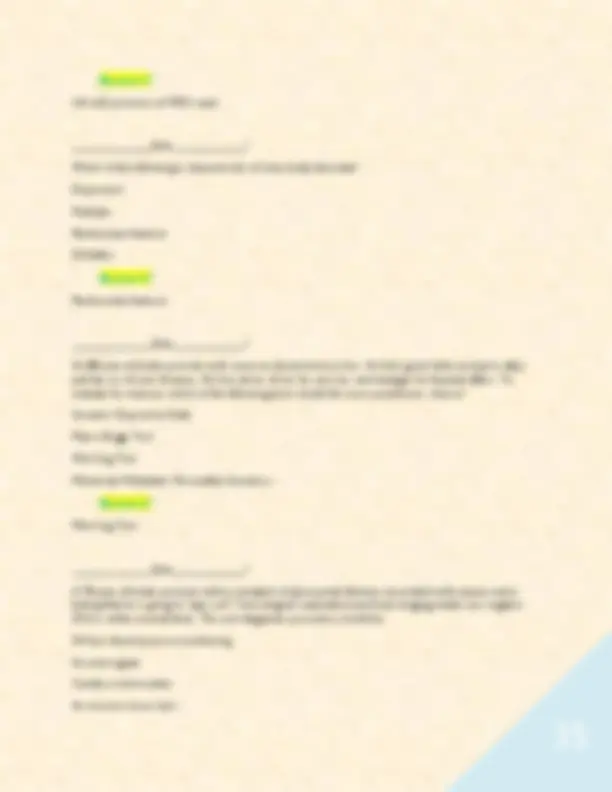
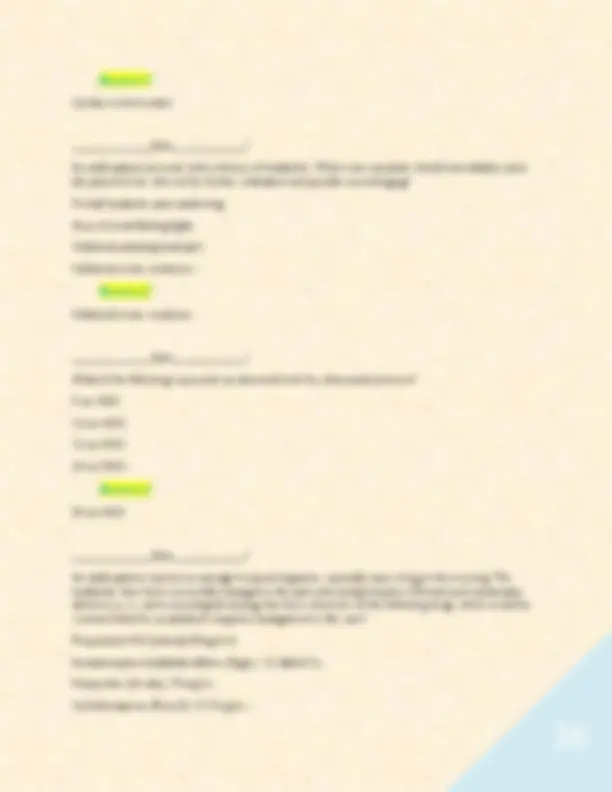
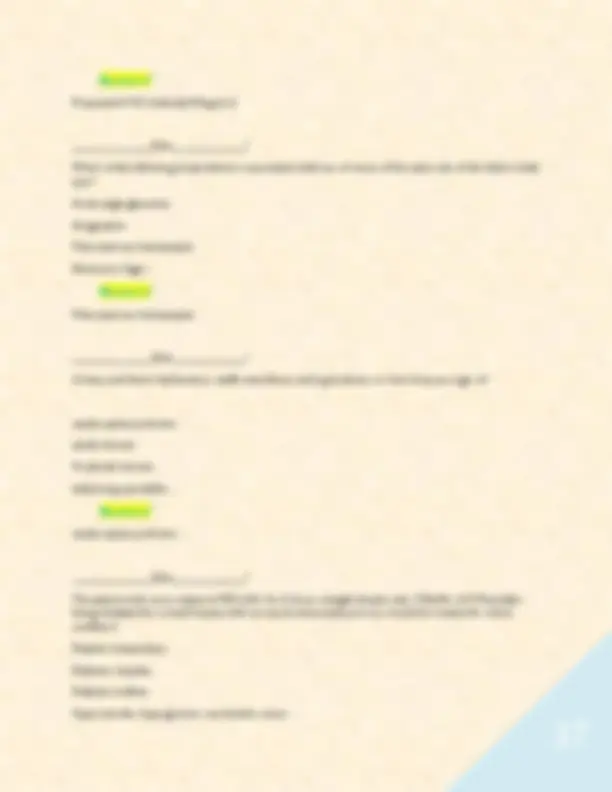
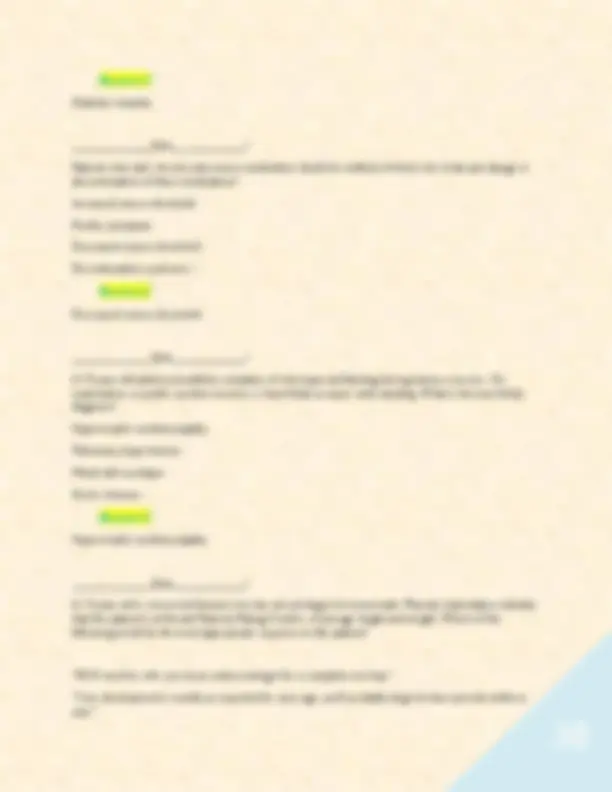
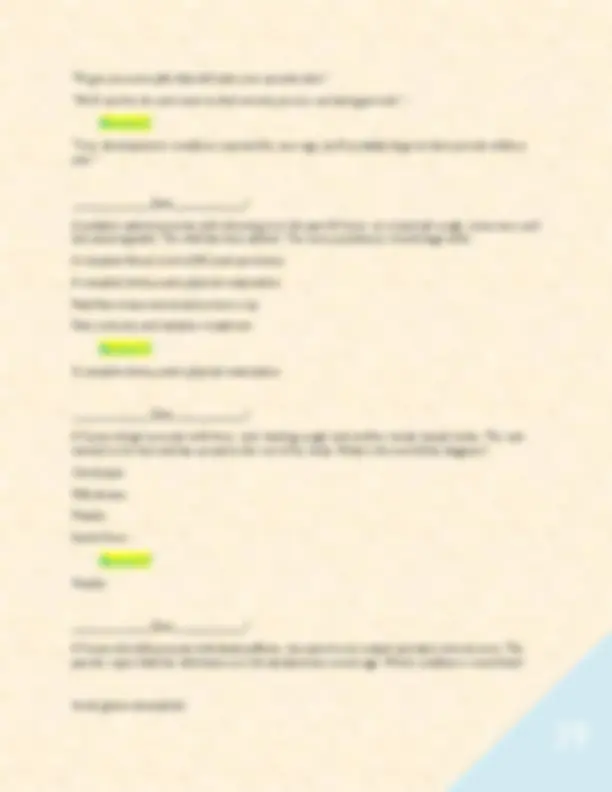
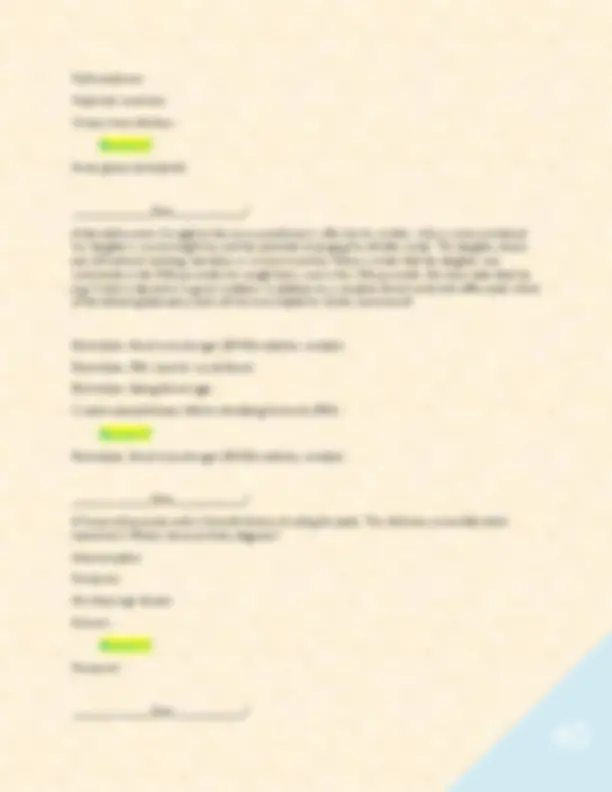
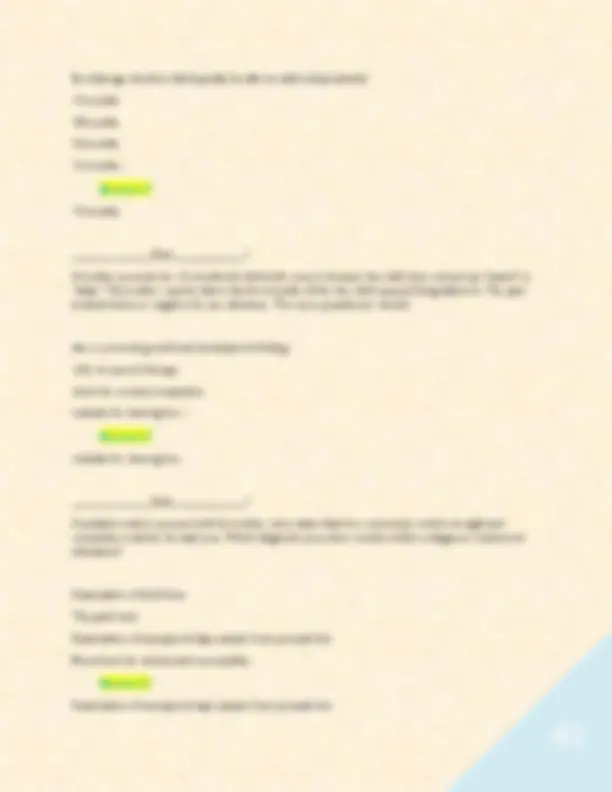
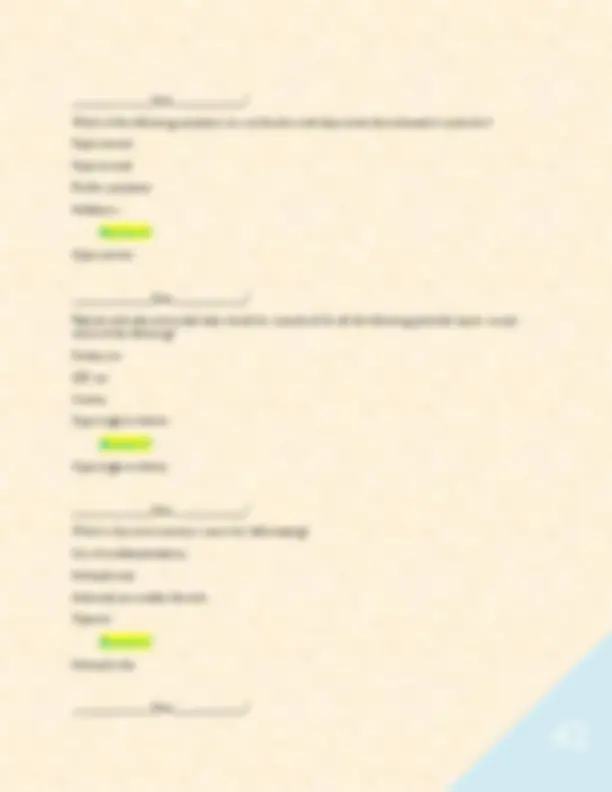
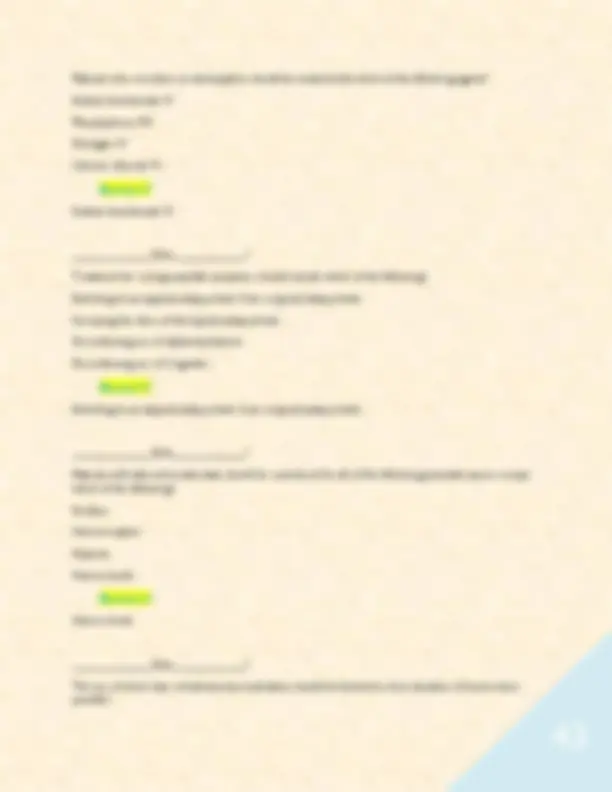
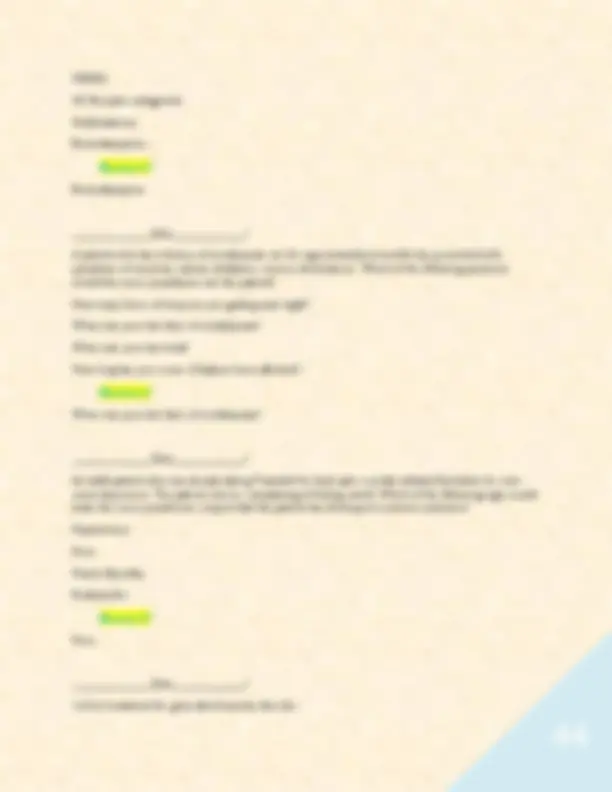
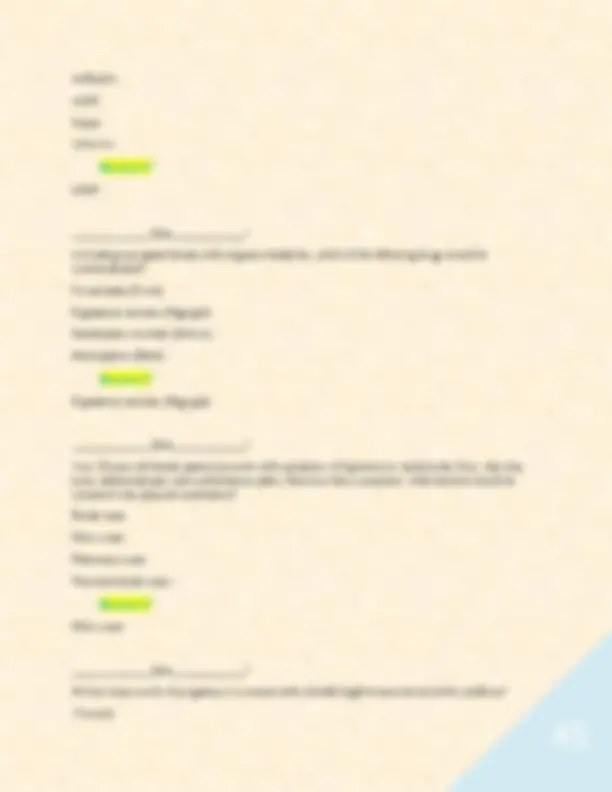
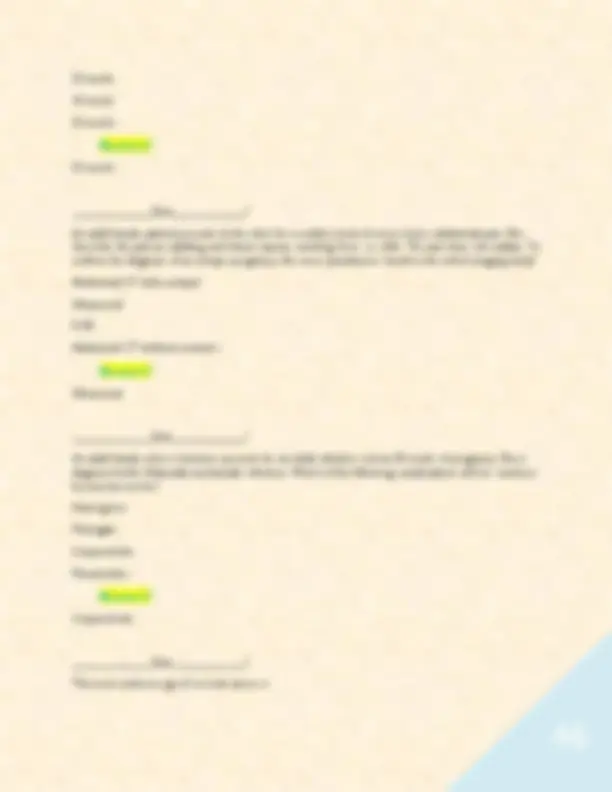
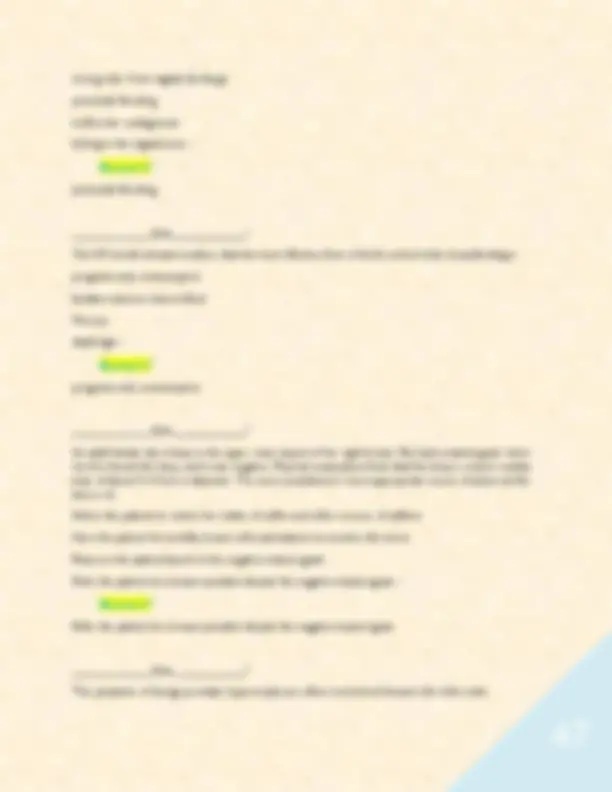
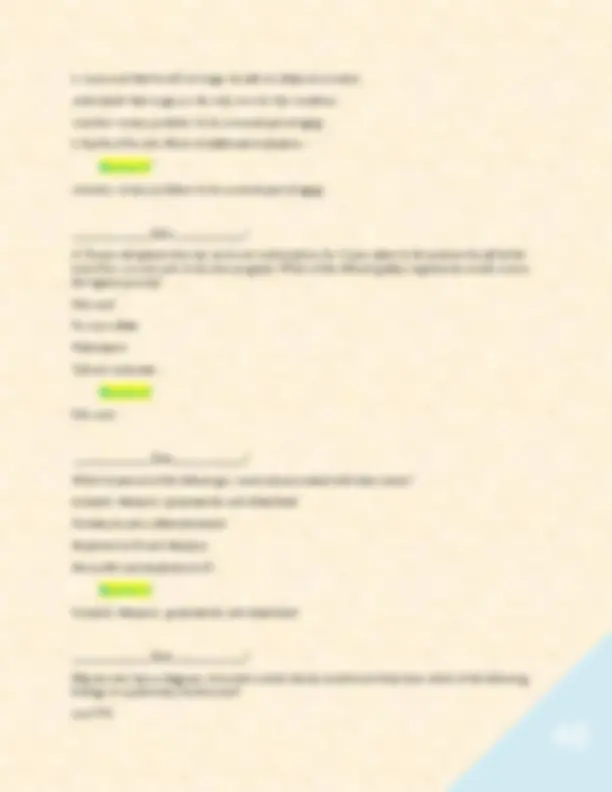
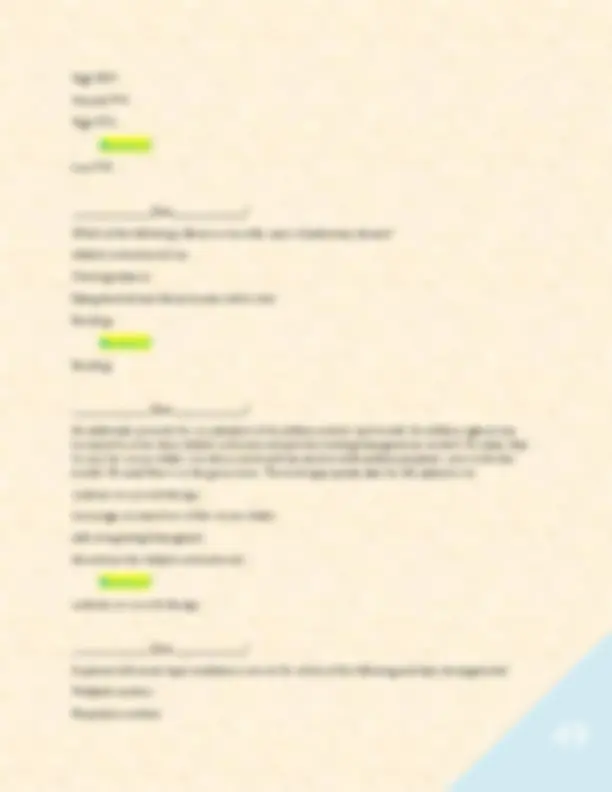
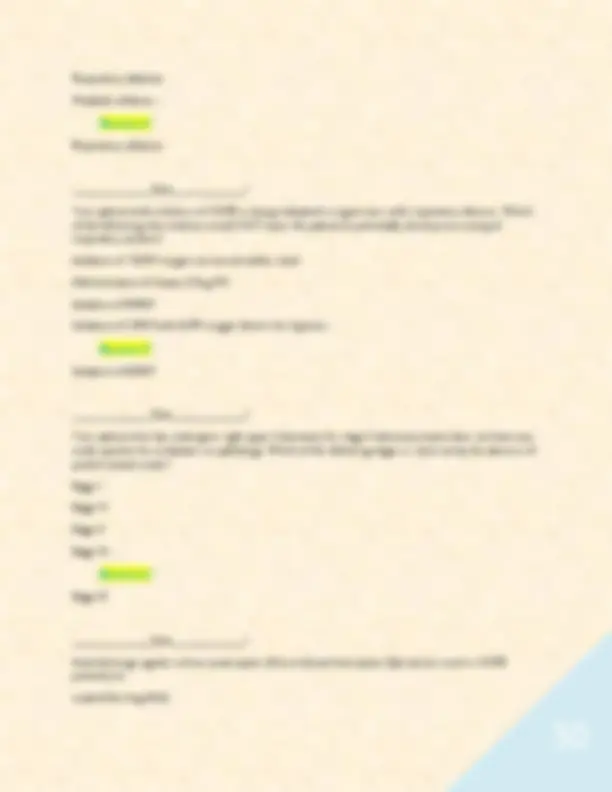
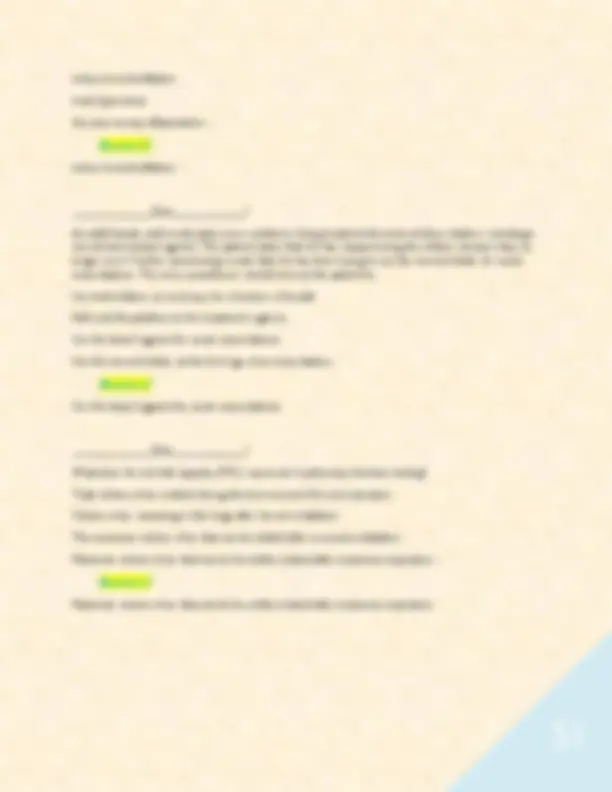


Study with the several resources on Docsity

Earn points by helping other students or get them with a premium plan


Prepare for your exams
Study with the several resources on Docsity

Earn points to download
Earn points by helping other students or get them with a premium plan
Community
Ask the community for help and clear up your study doubts
Discover the best universities in your country according to Docsity users
Free resources
Download our free guides on studying techniques, anxiety management strategies, and thesis advice from Docsity tutors
NR 667/NR 667 Practice Exam Week 2 / Study Guide Q-Bank / Expert Verified Actual Questions & Answers for Guaranteed Pass / Newest Update, 2025-2026 Terms in this set (149) _____________Quiz____________? Your 50-year-old male African American (AA) patient was found to have a blood pressure of 160/96 upon arrival to your clinic. He does not have any other medical conditions. For the following 24 hours of self-reported vital signs, it remained between 160-170 systolic and 90-100 diastolic without treatment. After finding all basic metabolic panel (BMP) lab values to be within normal limits, your first choice of antihypertensive is most likely which of the following agents? carvedilol metoprolol amlodipine lisinopril - Answer✓✓ amlodipine _____________Quiz____________? A patient is being followed for type 2 diabetes mellitus and hypertension. He also has a diagnosis of polycythemia vera and has regular phlebotomies for management. Which of the following s
Typology: Exams
1 / 51

This page cannot be seen from the preview
Don't miss anything!












































Terms in this set (149) _____________Quiz____________? Your 50-year-old male African American (AA) patient was found to have a blood pressure of 160/ upon arrival to your clinic. He does not have any other medical conditions. For the following 24 hours of self-reported vital signs, it remained between 160-170 systolic and 90-100 diastolic without treatment. After finding all basic metabolic panel (BMP) lab values to be within normal limits, your first choice of antihypertensive is most likely which of the following agents? carvedilol metoprolol amlodipine lisinopril -
amlodipine _____________Quiz____________? A patient is being followed for type 2 diabetes mellitus and hypertension. He also has a diagnosis of polycythemia vera and has regular phlebotomies for management. Which of the following statements about this patient is correct? The phlebotomies will improve his glycosylated hemoglobin levels The phlebotomies will increase his blood pressure He should increase dietary iron supplements
He should avoid dietary iron supplements -
He should avoid dietary iron supplements _____________Quiz____________? As the nurse practitioner working in a primary care clinic, you have been notified from a hospitalist that your long-term patient with a history of HFrEF (heart failure with reduced ejection fraction) with an ejection fraction of 40% two years ago who is also not on optimal medical therapy has been diagnosed with a myocardial infarction this admission and received emergent placement of a drug-eluting stent to the left anterior descending artery. As the patient's medical home who will manage this patient after discharge, which of the following would you expect to be a priority in the patient's care for their heart failure after an acute MI? Ordering a Holter monitor for 7 days post-discharge Ordering a new transthoracic echocardiogram and Lifevest if EF is less than 35% Ordering aspirin and clopidogrel for 3 months at discharge Ordering a new transthoracic echocardiogram and order a Lifevest if EF is less than 45% -
Ordering a new transthoracic echocardiogram and Lifevest if EF is less than 35% _____________Quiz____________? A 70-year-old man with a history of atrial fibrillation presents with sudden-onset left-sided weakness and slurred speech. What is the most likely diagnosis? Stroke Transient ischemic attack (TIA) Myocardial infarction (MI) Seizure -
Stroke _____________Quiz____________? A 55 year-old female patient with no previous cardiac history and no family history of hyperlipidemia with an acute myocardial infarction is treated successfully with a drug-eluting stent during a recent
_____________Quiz____________? What is the key long-term benefit of using carvedilol for patients with coronary artery disease and heart failure with reduced ejection fraction (HFrEF)? Baseline reduction of blood pressure Increase in libido Potential increase in ejection fraction Reduce in cardiac output -
Potential increase in ejection fraction _____________Quiz____________? An otherwise healthy patient reports episodes of palpitations lasting less than 5 minutes and occurring 3-5 times daily. The patient describes a substernal flip-flop sensation with a sudden rapid heart rate, ending with a forceful beat. Holter monitoring would most likely document: Premature ventricular contraction (extrasystole) Paroxysmal supraventricular tachycardia Sinus tachycardia Atrial flutter -
Paroxysmal supraventricular tachycardia _____________Quiz____________? Which of the following people groups represent the least risk of cardiac disease? Native Hawaiians American Indians Caucasians African Americans -
Caucasians
_____________Quiz____________? An adult female presents with a chief complaint of fatigue and weight gain. She states that she doesn't feel like herself. A diagnosis of hypothyroidism is suspected. Which of the following physical findings would support this diagnosis? Dry skin, bradycardia, and hypoactive deep tendon reflexes Tachycardia, exophthalmos, brittle hair Diarrhea, tachycardia, and hypoactive deep tendon reflexes Palpitation, bradycardia, and constipation -
Dry skin, bradycardia, and hypoactive deep tendon reflexes _____________Quiz____________? An adult patient with type 2 diabetes mellitus returns at the nurse practitioner's request to discuss medication management. Current medications include metformin (Glucophage), 1000 mg twice daily, sitagliptin (Januvia), 10 mg daily, and insulin detemir (Levemir), 60 U daily. Lab values are: A1c = 10.4% [normal = less than 7.0%], fasting blood glucose = 180-190 mg/dL range [normal = less than 99 mg/dL]. Which of the following regimens should the nurse practitioner recommend? Basal insulin only, continuing oral medications Switching to glargine (Lantus) Basal and rapid-acting insulin Rapid-acting insulin only, continuing oral medications -
Basal and rapid-acting insulin _____________Quiz____________? Patients on levothyroxine should be monitored for signs of which one of the following: Angina pectoris and dysrhythmias Increased constipation and cramping Focal deficits and hyperreflexia Pedal edema and discomfort -
Visual field deficits _____________Quiz____________? An adult male is seen for an initial visit. He denies tobacco, drug, or alcohol use. He has a sedentary lifestyle and no family history of diabetes. BP = 120/80, P = 76, and BMI = 31. Which of the following diabetes screening tests should the nurse practitioner order? No screening is indicated until age 45 Urine for glycosuria Basic metabolic panel Fasting plasma glucose -
Fasting plasma glucose _____________Quiz____________? A 33-year-old woman presents with intermittent palpitations, anxiety, and heat intolerance. Her thyroid function tests reveal low TSH and high free T4. What is the most likely diagnosis? Hypothyroidism Hyperthyroidism Thyroiditis Graves' disease -
Hyperthyroidism _____________Quiz____________? A 40-year-old female presents with abnormal thyroid labs. Her labs show: TSH 0.25 (0.4-5.69), Free T 1.5 (0.5-1.1), TSI antibody positive. You counsel her that: She likely has autoimmune hypothyroidism and will need thyroid hormone replacement She likely has autoimmune hyperthyroidism, and a thyroid uptake scan and US may be helpful She likely has a multinodular toxic goiter Plan to monitor her for S&S and repeat labs in 6-8 weeks -
She likely has autoimmune hyperthyroidism, and a thyroid uptake scan and US may be helpful _____________Quiz____________? A 39-year-old male with type 1 DM is seen in the urgent care after a recent hospitalization for DKA. Treated with IV fluids, IV insulin, and potassium correction, His BS decreases to 120 mg/dL and is transitioned from IV insulin to Sub Q. After 6 hours he begins vomiting and ABG is done: pH 7.19, CO 13, K+ 5.5, glucose 180. Which of the following is the most likely reason for persistent acidosis? Failure to give bicarbonate Premature discontinuation of insulin drip Failure to correct hyperkalemia Lack of absorption of Sub Q insulin -
Premature discontinuation of insulin drip _____________Quiz____________? The management of COPD in the elderly is best guided by: symptomatology. radiologic imaging. spirometry. arterial blood gases. -
symptomatology. _____________Quiz____________? A 92-year-old presents with a decline in personal care and increasing forgetfulness. They had a CVA a three years ago with mild cognitive changes then which has slowly progressed. The more likely diagnosis in this case is? Alzheimer's dementia Lewy-body dementia Progressive vascular dementia
Decreased incidence of gallstones -
Decreased production of gastric acid _____________Quiz____________? Your patient is suspected to have colon cancer. Which labs/marker are important to be performed on this patient? CEA CA- AFP BRCA 1 and 2 -
_____________Quiz____________? Which of the following findings is typically a sign of acute appendicitis? Positive Prehn's sign A negative psoas sign Positive Murphy's sign A positive Rovsing's sign -
A positive Rovsing's sign _____________Quiz____________? A 54-year-old male who is 30 pounds overweight states that he awakens at night with heartburn and the taste of hot acid in his mouth. Stress makes his condition worse, yet baking soda seems to provide some relief. Findings on examination are normal and the stool for occult blood is negative. The preliminary diagnosis should be: esophagitis. helicobacter pylori. gastroesophageal reflux disease.
esophageal spasm. -
gastroesophageal reflux disease. _____________Quiz____________? Adult patient with left lower quadrant abdominal pain dx with diverticulitis. No allergies. Following is tx of choice: Bactrim Prednisone Medrol Keflex -
Bactrim _____________Quiz____________? An adult female presents with profus, watery diarrhea and loss of appetite for the past 5 days with 4- stools per day. Stool cultures are positive for C Diff. Patient cannot afford Vancomycin. The most appropriate antibiotic is: Bactrim Doxycyline Augmentin Metrondiazole -
Metrondiazole _____________Quiz____________? A 45-year-old woman presents with chronic diarrhea, weight loss, and abdominal pain. Endoscopy reveals villous atrophy of the small intestine. What is the most appropriate initial management? Antibiotics Gluten-free diet High-fiber diet
Fluid and electrolyte management, self-limiting _____________Quiz____________? A 59-year-old male presents with symptoms of abdominal pain, jaundice, and weight loss which he has not been trying to lose weight. What would be a malignancy associated with these symptoms? Adenocarcinoma Barrett's Esophagus Esophageal cancer Pancreatic cancer -
Pancreatic cancer _____________Quiz____________? Multimodal analgesia involves the use of multiple agents to avoid reliance on which particular class of medication? Muscle relaxants Opioids NSAIDS Topical analgesia agents -
Opioids _____________Quiz____________? Evidence based health screening is utilized with an understanding of the limits of interpreting the results. In this context, the term sensitivity refers to the ability of a test to: Detect the prevalence of a given condition Identify the specific condition Provide reproducible results -
Detect the prevalence of a given condition _____________Quiz____________? Which of the following risks of patient use of convenient/urgent care may increase the risk of a nurse practitioner to miss subtle changes in the patient's condition over time? Overtesting Repeating of tests Lack of longitudinal management and trending Overuse of medical imaging -
Lack of longitudinal management and trending _____________Quiz____________? A patient states they do not want to have any further medical care and wishes to leave against medical advice. Unknown to you, the healthcare tech then held their arm down to get an IV catheter placed against their will. The healthcare tech is at risk of being charged with which of the following: Verbal assault None of these options Verbal battery Battery -
Battery _____________Quiz____________? An adult patient presents with acute onset of right eye pain, redness and decreased vision. Suspecting open-angle glaucoma, the nurse practitioner should: Refer to ophthalmology and prescribe topical steroid Prescribe antibiotic ointment and pilocarpine Advise applying warm compresses and returning in the morning
Hyphema _____________Quiz____________? An adult patient presents with complaints of acute-onset unilateral right eye pain, visual changes, seeing halos around lights, abdominal pain, and intermittent nausea. Physical findings include an erythematous right eye without discharge, a cloudy cornea, and a moderately dilated right pupil that is non-reactive to light. The nurse practitioner should immediately: apply fluorescein stain and access for injury or foreign body refer the patient to the emergency department obtain a specimen for culture and sensitivity of the inflamed eye apply mydriatic drops for a funduscopic examination -
refer the patient to the emergency department _____________Quiz____________? An elderly patient has throbbing pain in the left eye, blurred vision, marked photophobia, and redness around the iris. What is the nurse practitioner's initial diagnosis? Glaucoma Sjogren's syndrome Conjunctivitis Iritis -
Iritis _____________Quiz____________? Which antibiotic is appropriate for initial treatment of sinusitis? azithromycin (Zpack) amoxicillin/clavulanic acid (Augmentin) penicillin (PCN)
Cefdinir -
amoxicillin/clavulanic acid (Augmentin) _____________Quiz____________? Your patient has a Le Fort III fracture and is admitted for close monitoring. Which of the following represent a potential complication of this type of fracture? Tetany Loss of bowel tone Sternocleidomastoid impingement Cerebrospinal fluid leak -
Cerebrospinal fluid leak _____________Quiz____________? Workup to rule out cardiac source of an embolic stroke should include which of the following exams? 12 Lead EKG Transthoracic or Transesophageal echocardiogram CT chest without contrast CT facial bones -
Transthoracic or Transesophageal echocardiogram _____________Quiz____________? Your patient with a large bump on their cheek should be evaluated and ruled out for which cardiac complication-linked diagnosis? Obstructed salivary gland Impacted molar Dental caries Perioral abscess -
Hydroxyurea Nonsteroidal anti-inflammatory drugs (NSAIDs) -
Hospitalization for intravenous fluids and opioids _____________Quiz____________? A 78 y.o. M patient reports chronic infections, bruising, fatigue, SOB, and fevers. He has a history of rectal adenocarcinoma and completed concurrent chemotherapy/radiation earlier this year. His CBC shows Hgb 7.5, PLT 88, WBC 1.2, ANC 0.8, and peripheral smear shows dysplasia. What additional work-up would you anticipate for this patient? Bone marrow biopsy and flow cytometry No additional work-up is required, these are expected sequela of his oncologic treatment Repeat CBC/CMP/peripheral smear in eight weeks Colonoscopy and fecal occult blood test -
Bone marrow biopsy and flow cytometry _____________Quiz____________? A patient currently undergoing concurrent chemotherapy/radiation treatment for glottic squamous cell carcinoma is admitted to the rehab unit you oversee for management of intractable nausea, vomiting, and dehydration. Admission CBC showed WBC 1.3, Hgb 7.5, PLT 45, ANC 0.8. Which of the following conditions is this patient at risk for? Aplastic anemia due to bone marrow suppression Macrocytic anemia due to B12 deficiency Microcytic anemia due to chronic kidney disease Iron deficiency anemia due to chronic blood loss -
Aplastic anemia due to bone marrow suppression _____________Quiz____________?
Overactivation of coagulation and fibrinolysis resulting in thrombosis and hemorrhage is a trademark of which of the following? Thrombocytopenia Disseminated intravascular coagulation Myelodysplastic syndrome Aplastic anemia -
Disseminated intravascular coagulation _____________Quiz____________? Which of the following is not a common mechanism of neutrophil expenditure and resultant neutropenia? Immune destruction Redistribution of neutrophils to the spleen or vascular endothelium Decreased neutrophil production in the bone marrow Loss of circulating neutrophils in acute blood loss -
Loss of circulating neutrophils in acute blood loss _____________Quiz____________? In which of the following patients is PRBC transfusion recommended? 52 y.o. F with chronic lower GI bleed, asymptomatic, and Hgb 8. 73 y.o. M with acute GI bleed and Hgb 6. 26 y.o. F s/p ORIF, Hgb 10. 64 y.o. M with anemia of unknown origin, SOB, fatigue, and Hgb 9.2 -
73 y.o. M with acute GI bleed and Hgb 6. _____________Quiz____________? All the following thrombocytopenic emergencies require immediate action except: